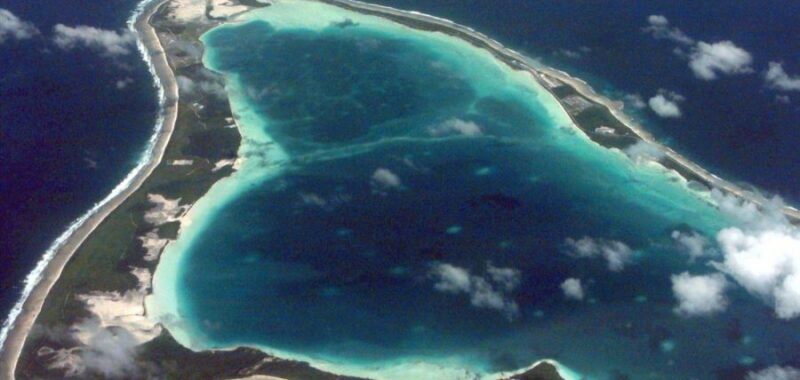
For nearly 50 years, Naval Support Facility Diego Garcia in the Indian Ocean has been a critical part of the American global strategic footprint. Located on the largest island in the Chagos Archipelago, the land is owned by the United Kingdom but has been leased to the U.S. for a 99-year period.
The military base’s stated mission is “to provide logistic support to operational forces forward deployed to the Indian Ocean and Persian Gulf AORs [Areas of Responsibility] in support of national policy objectives.” That bland language conceals a vital role in America’s security posture.
In 1990, NSF Diego Garcia delivered a Marine Expeditionary Brigade to Saudi Arabia as part of Operation Desert Shield, following the Iraqi occupation of Kuwait, and B-52G Stratofortress strategic bombers used it as a base for more than 200 operations. B-52s, B-1 Lancers and B-2 Spirit stealth bombers from there struck targets in Afghanistan from 2001 to 2006; this was crucial in fighting the Taliban and al Qaeda as nations closer to Afghanistan (Turkey, Pakistan and Saudi Arabia) refused to allow combat operations from bases in their territory.
Diego Garcia is part of the British Indian Ocean Territory (BIOT), one of the U.K.’s 14 overseas territories, final remnants of the British Empire. Last month, however, Prime Minister Keir Starmer announced that he had reached an agreement with the government of Mauritius under which the sovereignty of the BIOT would be transferred to Mauritius, subject to concluding a formal treaty.
However, that sovereignty will be “exercised with respect to Diego Garcia” by the U.K. for at least 99 years, securing the future of the military base. The agreement was welcomed by President Joe Biden because it “secures the effective operation of the joint facility on Diego Garcia into the next century.”
Why has this happened? That requires a brief dive into the history of the Chagos Archipelago. Although some 1,400 miles distant, it had for a century and a half been under the jurisdiction of the British Crown Colony of Mauritius, established in 1814.
By the 1960s, it was clear that Mauritius would soon be granted independence as part of the broader dismantling of the Empire. However, the U.S. was keen to find a location for a major military base in the Indian Ocean, and Diego Garcia, remote and sparsely populated, was chosen.
After agreement between the U.S. and the U.K., in 1965 the Colonial Office in London separated the Chagos Archipelago from Mauritius and formed the British Indian Ocean Territory. The population of 2,000 or so Chagossian Islanders was — forcibly and wrongly, it is now generally accepted — removed from Diego Garcia between 1967 and 1973, leaving the BIOT uninhabited and allowing construction of the base to proceed.
However, Mauritius, which became independent in 1968, never accepted the separation of the Chagos Archipelago, even though it was carried out when both were British colonies. Its constitution claims sovereignty and its government has pursued legal redress, which led to the U.N. General Assembly in 2017 referring the dispute to the International Court of Justice. Two years later, the court issued an advisory opinion declaring that the U.K. should cede sovereignty of the BIOT to Mauritius on the grounds that “the process of decolonization … was not lawfully completed.”
In 2022, Britain began talks with Mauritius over sovereignty, but they broke down late last year. The new Labour government resumed the talks, believing that the maintenance of U.K. sovereignty was impossible in the long term. After the recent agreement was concluded, Foreign Secretary David Lammy told the House of Commons that “the status quo was clearly not sustainable” and that a “binding judgement against the U.K. seemed inevitable … doing this deal on our terms was the sole way to maintain the full and effective operation of the base into the future.”
This inevitability is disputed. An independent Mauritius had never administered the Chagos Archipelago, and the argument over “decolonization” is as much a political as a legal one. However, the U.K. has made its decision.
It is not clear what in practice is meant by Britain “exercising” Mauritius’s sovereignty over Diego Garcia. It must be a lesser degree of control than being the sovereign power, but may look the same so long as goodwill is present on all sides. Nevertheless, skeptics are entitled to wonder if the presumption of goodwill is enough where a major strategic asset is concerned.
There are fears over Mauritius’s relationship with China. In 2019, China signed a free trade agreement with Mauritius, its first with any African nation, which has seen bilateral trade increase by 75 percent. China has also invested substantially in Mauritius; for example, the Mauritius Safe City Project was financed by a $455 million loan from the Export-Import Bank of China, and a lot of the surveillance technology is provided by Chinese companies.
Was the surrender of the British Indian Ocean Territory inevitable? The case is arguable. But neither warm words nor long leases can disguise that Diego Garcia’s strategic situation has been radically altered, and that unanswered questions remain.
Eliot Wilson is a freelance writer on politics and international affairs and the co-founder of Pivot Point Group. He was senior official in the U.K. House of Commons from 2005 to 2016, including serving as a clerk of the Defence Committee and secretary of the U.K. delegation to the NATO Parliamentary Assembly.

